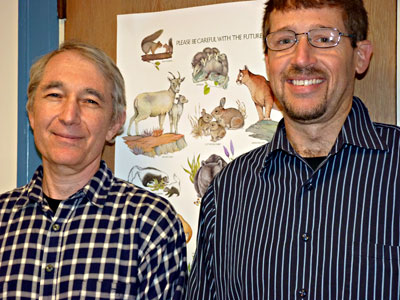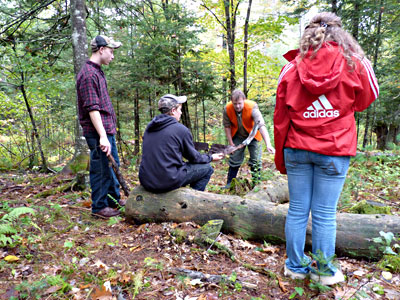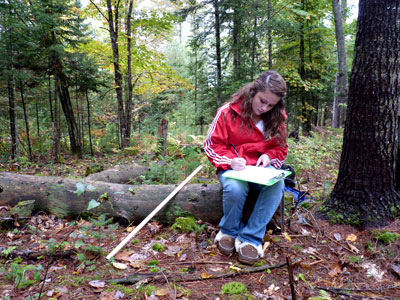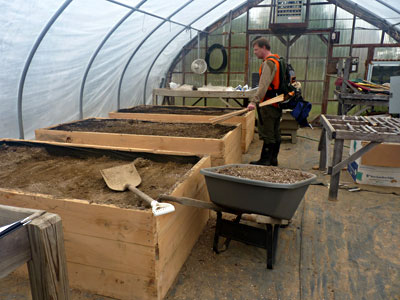 |
| Co-directors Emanuel Pariser and Troy Frost at Maine’s magnet school emphasizing project-based learning about agriculture, sustainability, forestry, business, alternative energy and the environment. English photo. |
By Jean English
On a typical day at the Maine Academy of Natural Sciences (MeANS), agricultural specialist Jeff Chase is outside exploring with a small group of students how the forest floor is important for forest health – for water, nutrients and regeneration. And as one student, Zach, points out, “Otherwise the forest would be floating in the air.”
The 20 students who started at MeANS in its first year seem to be floating in the air themselves, freer to explore the natural beauty and resources of Maine than they were in their former, traditional classrooms.
This trip to the woods reflects the goals of MeANS, Maine’s second magnet school after the Maine School of Science and Math: “As a student of the Academy, you will become a more engaged, reflective and self-directed learner. You will develop habits of the heart and mind that lead you to taking responsibility for your own actions as well as for the welfare of others, your community and your environment.
“You will grow as a critical thinker and a creative problem solver. It is the goal of the Academy that you will complete your high school education more hopeful, engaged, and healthy than when you enrolled. You will also have a plan for your next step in life as a young adult including further education, training, adventure, civic engagement and work.”
 |
| The building currently housing the Maine Academy of Natural Sciences on the grounds of Good Will-Hinckley in Fairfield. English photo. |
Renewing the Vision of Good Will-Hinckley
MeANS opened its doors to its first classes in the fall of 2011 on the grounds of the Good Will-Hinckley School on Route 201 in Fairfield. The Reverend George Walter Hinckley founded the school in 1898 with the belief that children learn best when they’re outside in nature. With more than 2,400 acres, Good Will-Hinckley supported at-risk children in a residential setting until 2009, when lack of funding closed the school.
In 2011, it opened again, this time to offer to high school students hands-on, project-based learning focusing on agriculture, sustainability, forestry, business, alternative energy and the environment. Funding comes from the Legislature and scholarships from the former school’s endowment, from annual fundraising, school districts that support their students with tuition, grants from foundations and corporations, and some parent tuitions.
Learning by Inventorying the Forest
The MeANS goals are front and foremost as Jeff Chase, a graduate of Unity College, a MOFGA volunteer for 22 years, and the 2004-2005 Agriculture Teacher of the Year for Maine Agriculture in the Classroom, works with Dylan, Zach, Zoe and Caleb this day to prepare for setting up Forest Inventory Growth (FIG) plots with a state forester. Later the class will explore the ecology of the forest with a state soil scientist, an entomologist and a wildlife biologist.
 |
| Agriculture teacher Jeff Chase demonstrating random sampling in a plot to inventory forest growth. English photo. |
On this day they are learning how to establish FIG plots in order to collect data to share with other Maine and U.S. schools as part of Project Learning Tree (www.plt.org). They measure a 66-by-66-foot area, and then Chase explains the idea of random sampling. Each student throws a stick into the plot, stands where the stick landed, and records the living and nonliving occupants of the square meter area around that spot. Then, to satisfy the writing requirement for the day, each student writes a paragraph (fictitious or not) about the plot.
Dylan says that he came to MeANS because he prefers being outside, doing what he enjoys, rather than sitting in a classroom all day. Caleb hopes to further what he learns at MeANS by going to Unity College to become a game warden. Zach is interested in logging, and Zoe says she loves animals. The four are among the students accepted for MeANS’ inaugural year, 11 living on campus and 9 commuting.
Developing a Plan
The school population is fairly evenly split among freshmen, sophomores, juniors and seniors, although “all are functioning at quite different levels academically,” says school co-director Emanuel Pariser. He and co-director Troy Frost have found that groups of five work well outdoors. “It’s a more cohesive working group,” says Pariser. “When there are more, some are standing around.”
The indoor class time generally consists of groups of five as well, but ultimately will be more individualized. Students begin by studying thematic units and then develop Personal Learning Plans that reflect their interests and meet their needs for graduation.
 |
| Zoe, a student at MANS, writes about the items inventoried in a forest plot that she sampled. English photo. |
Pariser, who, with Dora Lievow, started the renowned alternative Community School in Camden, Maine, for high school students, says that MeANS “is like the Community School in that there is real weight on experiential learning. The difference is, there are more students; and some live on campus, while others don’t, so there are different cultures going on.”
Of some 30 students who applied to MeANS in the first year, some were not accepted because they did not do a task they were asked to do, or the coordinators did not think the school could meet their needs.
“We’re not a behavioral program,” says Pariser. “That’s not our primary focus. We won’t accept someone who needs constant attention or supervision. A good percentage do need a smaller learning environment. They don’t want to be in a traditional classroom, and it doesn’t work well for them. Things work better when they can work with their hands, walk, observe.” None of the students now at the school was doing well in “regular school.”
Projected Growth
 |
| Jeff Chase in the greenhouse where students have constructed raised beds and will be growing food. English photo. |
By fall 2012, the directors hope to have 40 to 45 students and more teachers; and by 2013, about 65 students. If MeANS achieves charter school status, which would ensure more stable funding, the program can continue to grow. (The Maine Legislature has approved the existence of charter schools but the state is still creating rules to govern the schools.)
MeANS is ideal for becoming a charter school, says Pariser, because it has a theme, has the environmental resources for farming and forestry, and has the ability to become a green school. He notes that although Maine is 90 percent forested, no secondary program centers on that resource; and no other high school focuses on farming the way MeANS does.
“A lot of great stuff is going on, but it has been peripheral – not at the core of a school’s mission. People are starting to realize the importance of these things, but education is so compartmentalized in some people’s minds that it’s hard for some to see that farming can include all disciplines.”
At MeANS, part of that farming curriculum will include growing crops in a 900-square-foot, propane-heated greenhouse, in 4-by-8-foot beds that are 2 feet high. The students will also start seedlings on tables that will sit on the raised beds.
Caleb is building a gravity-fed watering system for the greenhouse. He connected with a Good Will-Hinckley alum knowledgeable about the topic and is drawing plans and calculating materials needed. Such interdisciplinary projects can teach skills in English, history, math, science and more.
The students will also be practicing composting, recycling and tending livestock; and they’ll be growing food outdoors for students who live on campus.
Pariser notes that “many people now don’t know how to cook. If the economic rug is pulled out from under us, we’re in bad shape. I hope these kids will have sustainable lives; that they’ll know how the land can help them survive independent of the economy. There is so much energy around the food- and farm-to-school movement. I think the best thing we can do for teens is put them in the presence of adults who are really excited about what they’re doing.” The Skowhegan area has much to offer in this regard, he adds, with its gristmill, farmers’ market and other agricultural projects.
Kennebec Valley Community College hopes to buy some 680 acres of the campus and a few buildings there to establish a two-year agriculture program. Students at MeANS will be able to transition to or co-enroll in KVCC.
MeANS also hopes to be a site for Unity College interns in outdoor recreation and teaching curricula; and MeANS hopes to connect some of its students with the college, which offers majors and a hands-on educational approach that many of them seek.
The students have already connected with MOFGA, volunteering to help set up tents at the Common Ground Fair and giving a presentation at the Fair about the school. They hope to connect with MOFGA’s Low Impact Forestry committee and to have speakers from MOFGA come to MeANS. One day per week the school features an afternoon speaker. Interested students may end up interning or job shadowing with that speaker.
Pariser has an interdisciplinary Ph.D. in education and psychology. His work at Good Will-Hinckley complements his work at the Community School, where the relationship between teacher and student is a central organizing principle. He was hired to help start MeANS “because they want me to design the program and bring my experience with starting a school, assembling a staff, the principles we’ll be working under.” He’s co-directing the school with Troy Frost this year, as both find out which ideas are solid for the school and which need work.
“This is something that hasn’t been tried in Maine before,” says Pariser; “a whole school based around a theme that involves many aspects that are not in traditional schools: project-based learning, restorative circles, a strong connection with an advisor, and tapping into the food systems and natural resource systems of Maine and making them part of the educational experience.”
The MeANS students and staff may be floating in the air with the optimism of this first year at the school, but the staff is also creating the kind of organic base that should firmly root and nourish the program, just like a good organic soil.
A Typical Day at the Maine Academy of Natural Sciences
| 7:30 | Teacher arrival |
| 7:45 to 8:20 | Student arrival, breakfast, group sharing |
| 8:20 to 9:50 | Project-based learning for group 1; academic time for group 2 |
| 9:50 to 10:05 | Transition time |
| 10:05 to 11:30 | Project-based learning for group 2; academic time for group 1 |
| 11:30 to 11:55 | Fitness time |
| Noon to 12:40 | Lunch |
| 12:40 to 1:10 | Project time with advisor |
| 1:10 to 1:40 | Career focus time with advisor |
| 1:40 to 2:15 | Personal Learning Plan time with advisor |
| 2:15 to 2:30 | Departure |
| 2:30 to 3:30 | Teacher planning and reflection time |
